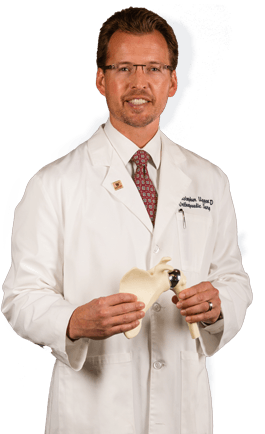Knee
Conditions
Knee Arthritis
Arthritis is a general term covering numerous conditions where the joint surface or cartilage wears out. The joint surface is covered by a smooth articular surface that allows pain-free movement in the joint. This surface can wear out for a number of reasons, often the definite cause is not known.
Anterior Cruciate Ligament (ACL) Tears
The anterior cruciate ligament, or ACL, is one of the major ligaments of the knee that is in the middle of the knee and runs from the femur (thigh bone) to the tibia (shin bone). It prevents the tibia from sliding and rotating out in front of the femur. Together with posterior cruciate ligament (PCL), medial collateral ligament (MCL), and lateral collateral ligament (LCL), it provides stability to the knee.
Meniscal Tears
A meniscal tear is a tear that occurs in the cartilage cushion of the knee. The meniscus is a small, "C" shaped piece of cartilage in the knee joint. Each knee has two menisci, the medial meniscus on the inner aspect of the knee and the lateral meniscus on the outer aspect of the knee. The medial and lateral menisci act as cushions between the thigh bone (femur) and shin bone (tibia).
Ligament Injuries
The knee is a complex joint which consists of bone, cartilage, ligaments and tendons that are responsible for joint movements. These structures are susceptible to various kinds of injuries. Knee problems may arise if any of these structures get injured by overuse or suddenly during sports activities or trauma. Pain, swelling, and stiffness are the common symptoms of any damage or injury to the knee.
Cartilage Defect / Injury
Articular or hyaline cartilage is the tissue lining the surface of the two bones in the knee joint. Cartilage helps the bones move smoothly against each other and can withstand the weight of the body during activities such as running and jumping. Articular cartilage does not have a direct blood supply to it so has less capacity to repair itself. Once the cartilage is torn it will not heal easily and can lead to degeneration of the articular surface, leading to development of osteoarthritis.
Knee Patellofemoral Instability
The knee can be divided into three compartments: patellofemoral, medial and lateral compartment. The patellofemoral compartment is the compartment in the front of the knee between the knee cap and thigh bone. The medial compartment is the area on the inside portion of the knee, and the lateral compartment is the area on the outside portion of the knee joint. Patellofemoral instability means that the patella (kneecap) moves out of its normal pattern of alignment in its groove. This malalignment can damage the underlying cartilage.
Loose Body
Loose bodies are small loose fragments of cartilage or bone that float around the joint. The loose bodies can cause pain, swelling, locking and catching of the joint. Loose bodies often occur with osteoarthritis. Other causes include fractures, trauma, bone and cartilage inflammation, and benign tumors of the synovial membrane.
Procedures
Knee Arthroscopy
Knee Arthroscopy is a common surgical procedure performed using an arthroscope, a viewing instrument, to look into the knee joint to diagnose or treat a knee problem. Most patients discharge from the hospital on the same day of surgery.
Meniscus Repair
The meniscus are two C-shaped pieces of cartilage located between thighbone and shin bone that act as shock absorbers and cushion the joints. The meniscus distributes the body weight uniformly across the joint and avoids the pressure on any one part of the joint and development of arthritis. Menisci are prone to wear and tear and meniscal tear is one of the most common knee injuries. Meniscal tear may occur in people of all ages and is more common in individuals who play contact sports.
Partial Meniscectomy
Partial meniscectomy is a surgical procedure indicated in individuals with torn meniscus where non-surgical treatments have failed to relieve the pain and other symptoms. Partial meniscectomy is recommended based on the ability of meniscus to heal, patient’s age, health status and activity level.
ACL Reconstruction
The anterior cruciate ligament is one of the major stabilizing ligaments in the knee. It is a strong rope- like structure located in the center of the knee running from the femur to the tibia.
ACL Reconstruction Patellar Tendon
Anterior cruciate ligament (ACL) reconstruction patellar tendon is a surgical procedure that replaces the injured ACL with a strip of patellar tendon. The anterior cruciate ligament is one of the four major ligaments of the knee that connects the femur (thigh bone) to the tibia (shin bone) and helps stabilize the knee joint. The anterior cruciate ligament prevents excessive forward movement of the lower leg bone (tibia) in relation to the thigh bone (femur) as well as limits rotational movements of the knee.
ACL Reconstruction Hamstring Tendon
Anterior cruciate ligament (ACL) reconstruction with hamstring method is a surgical procedure that replaces the injured ACL with a hamstring tendon. The anterior cruciate ligament is one of the four major ligaments of the knee that connects the femur (thigh bone) to the tibia (shin bone) and helps stabilize your knee joint. The anterior cruciate ligament prevents excessive forward movement of the lower leg bone (the tibia) in relation to the thigh bone (the femur) as well as limits rotational movements of the knee.
Osteochondral Allograft
An osteochondral allograft is a piece of tissue taken from a diseased donor to replace damaged cartilage that lines the ends of bones in a joint. A section of cartilage and bone is removed, shaped to precisely fit the defect and then transplanted to reconstruct the damage.
Cartilage Restoration
Articular or hyaline cartilage is the tissue lining the surface of the two bones in the knee joint. Cartilage helps the bones move smoothly against each other and can withstand the weight of the body during activities such as running and jumping. Articular cartilage does not have a direct blood supply to it so has little capacity to repair itself. Once the cartilage is torn it will not heal easily and can lead to degeneration of the articular surface, leading to development of osteoarthritis.
Patella Stabilization
The patella (knee cap) is a bone attached to the quadriceps muscles of the thigh by quadriceps tendon and to the shinbone by the patella tendon. The patella glides on the femoral groove and forms a patellofemoral joint. The patella is stabilized in its groove by a ligament called the medial patellofemoral ligament (MPFL).
Posterior Cruciate Ligament Reconstruction
The posterior cruciate ligament (PCL), one of four major ligaments of the knee, is located at the back of the knee. It connects the thighbone (femur) to the shinbone (tibia). The PCL limits the backward motion of the shinbone.
Posterolateral Corner Reconstruction
Posterolateral corner injury is damage or injury to the structures of the posterolateral corner. The structures of the posterolateral corner include the lateral collateral ligament, the popliteus tendon, and the popliteo-fibular ligament. Injuries to the posterolateral corner most often occur with athletic trauma, motor-vehicle accidents, and falls. An isolated injury to the posterolateral corner is rare. Posterolateral corner injuries often occur in combination with injuries to the cruciate ligaments, the anterior cruciate ligament (ACL) and the posterior cruciate ligament (PCL).
Medial Collateral Ligament Repair & Reconstruction
The medial collateral ligament (MCL) is the ligament that is located on the inner part of the knee joint. It runs from the femur (thigh bone) to the top of the tibia (shin bone) and helps in stabilizing the knee. Medial collateral ligament (MCL) injury can result in a stretch, partial tear, or complete tear of the ligament. Injuries to the MCL commonly occur as a result of trauma forces to the outside part of the knee.
Anterolateral Ligament Reconstruction
The anterolateral ligament (ALL) is a band of tissues extending obliquely from the lower protuberance of the femur (thigh bone) to the upper and outer end of the tibia (shin bone). It provides stability during rotational movements of the knee.
Knee injuries are usually caused by twisting activities, which ruptures the anterior cruciate ligament (ACL) inside the knee. The ALL is also thought to rupture sometimes in the process. Reconstruction of just the ACL can sometimes leave the knee with increased laxity, so a combined ACL and ALL reconstruction may be recommended to improve stability.
Osteotomy
High tibial osteotomy is a surgical procedure performed to relieve pressure on the damaged site of an arthritic knee joint.
It is usually performed in arthritic conditions affecting only one side of your knee and the aim is to take pressure off the damaged area and shift it to the other side of your knee with healthy cartilage. During the surgery, your surgeon will remove or add a wedge of bone either below or above the knee joint depending on the site of arthritic damage.
Knee Replacement
Total knee replacement, also called total knee arthroplasty, is a surgical procedure in which the worn out or damaged surfaces of the knee joint are removed and replaced with artificial parts. The knee is made up of the femur (thigh bone), the tibia (shin bone), and patella (kneecap). The meniscus, the soft cartilage between the femur and tibia, serves as a cushion and helps absorb shock during motion. Arthritis (inflammation of the joints), injury, or other diseases of the joint can damage this protective layer of cartilage, causing extreme pain and difficulty in performing daily activities. Your doctor may recommend surgery if non-surgical treatment options have failed to relieve the symptoms.
Medial Quadriceps Tendon Femoral Ligament (MQTFL) Reconstruction
Medial quadriceps tendon femoral ligament ligament (MQTFL) reconstruction is a surgical procedure indicated in patients with more severe patellar instability. Medial quadriceps tendon femoral ligament is a band of tissue that extends from the femur to the quadriceps insertion at the patella. Medial quadriceps tendon femoral ligament is the major ligament which stabilizes the patella and helps in preventing patellar subluxation (partial dislocation) or dislocation. This ligament can rupture or get damaged when there is patellar lateral dislocation. Dislocation can be caused by direct blow to the knee, twisting injury to the lower leg, strong muscle contraction, or because of a congenital abnormality such as shallow or malformed joint surfaces.













